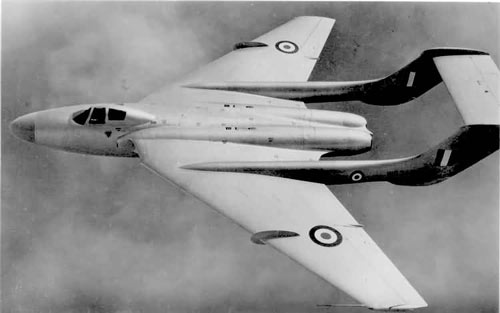De Havilland DH.110 Sea Vixen
Summary
| Category | Combat aircraft |
| Origin country | 🇬🇧 United Kingdom |
| First flight | 26 September 1951 |
| Year of introduction | 1959 |
| Number produced | 151 units |
| Average unit price | $1.5 million |
Description
Robustly built and designed as a two-seater aircraft, the Sea Vixen was developed to provide the Royal Air Force and the Royal Navy with an all-weather fighter equipped with a powerful radar and missiles. During the height of the Cold War, it was imperative for the British military to replace outdated night fighters such as the Meteor or Venom.
Following a fierce competition with another project, the Gloster Javelin, which was selected by the RAF, the Sea Vixen eventually gained favor with the Fleet Air Arm of the Royal Navy. In addition to its "double-bay" fuselage design, the Sea Vixen was characterized by its offset canopy position on the left side, with the right side dedicated to the navigator who occupied a small space known as the "coal hole."
The first prototype of the Sea Vixen, designated DH.110, made its inaugural flight on September 26, 1951, with pilot John Cunningham at the controls. However, its early development was marred by a tragic accident that claimed the lives of 31 people, including the pilot and co-pilot, during an attempted supersonic flight at the Farnborough Air Show on September 6, 1952. Significant modifications were made following this incident, leading to the creation of a non-folding wing variant for naval operations in 1955.
The following year, the Sea Vixen FAW.20 (later redesignated as FAW.1, with FAW standing for "Fighter All Weather") finally took to the skies. The first production Sea Vixen entered service with the Royal Navy in July 1959, armed with four Havilland "Firestreak" air-to-air missiles. This marked the Royal Navy's first missile-armed interceptor. Additional armament included two 51mm rocket pods paired with 225kg bombs or two 450kg bombs.
A total of 119 FAW.1 Sea Vixens were built. However, an improved FAW.2 version powered by two Rolls-Royce Avon 208 engines, capable of reaching speeds of 1,110 km/h, and armed with RedTop missiles, entered service from February 1964 onwards. Only 29 aircraft of the FAW.2 variant were constructed, with approximately 67 FAW.1s being converted to FAW.2s.
The DH.110 Sea Vixen saw action in numerous conflicts worldwide, including the Indonesian Confrontation (1962-1966) and the Aden Crisis (1967). During the Aden Crisis, a design flaw involving excessive recoil forces on the cannons became evident. The adopted solution involved placing a wooden buffer to absorb the recoil. As a result, the DH.110 Sea Vixen became the last British aircraft to incorporate wood in its design.
The remaining Sea Vixens were retired from naval service in January 1972. Remarkably, these aircraft were in a remarkably fresh condition, particularly their fuselages. Some Sea Vixens continued their careers as target drones (D.3 variant) or participated in aerial acrobatic demonstrations, including with the Simons Sircus, Fred's Five, and the Red Bull team.
Technical specifications
| Version: Sea Vixen FAW.2 | |
|---|---|
| Crew | 1 pilot + 1 WSO |
| Operational range | 1270 km (789 mi) |
| Maximum speed | 1127 km/h (700 mph) |
| Wing area | 60.2 m² (648.0 sqft) |
| Wingspan | 15.5 m (51.0 ft) |
| Height | 3.3 m (10.8 ft) |
| Length | 16.9 m (55.6 ft) |
| Service ceiling | 15000 m (49213 ft) |
| Empty weight | 12680 kg (27955 lbs) |
| Max. takeoff weight | 21205 kg (46749 lbs) |
| Climb rate | 46.0 m/s (150.9 ft/s) |
| Powerplant | 2 × turbojets Rolls-Royce Avon 208 delivering 5097 kgp |
| Ejection seat | Martin-Baker Mk 4 |
Current operating countries
No country is operating the DH.110 Sea Vixen in 2025.
All operators
Armament
Missiles payload:
- Air-to-Air Short-Range De Havilland Firestreak
Photo of DH.110 Sea Vixen
